Photophysics of metal-organic frameworks: A brief overview
Qingshuo Liu(劉晴碩), Junhong Yu(余俊宏), and Jianbo Hu(胡建波),2,?
1State Key Laboratory for Environment-Friendly Energy Materials,Southwest University of Science and Technology,Mianyang 621010,China
2Laboratory for Shock Wave and Detonation Physics,Institute of Fluid Physics,China Academy of Engineering Physics,Mianyang 621900,China
Keywords: metal-organic framework(MOF),ultrafast spectroscopy,photophysics,carrier dynamics
1.Introduction
Metal-organic frameworks (MOFs) represent an innovative category of porous crystalline materials formed through the linkage of organic ligands with metal ions or clusters.[1]The framework structure of MOFs arises from the coordination between organic ligands and metal ions via covalent bonds.The coordination number of the metal ions determines the overall architecture of the MOF.Metal ions with higher coordination numbers tend to self-assemble into threedimensional MOF materials, while metal ions with lower coordination tend to form two-dimensional or one-dimensional MOF materials.[2]The coordination of ligands to metal ions can result in the formation of aggregated ion clusters,leading to the emergence of secondary and superstructural units,thereby augmenting the diversity of coordination modes within MOFs.Notably,the structure of MOF materials is not only influenced by the variety of metal ions but also by the coordination modes of organic ligands.[3]In MOFs, metal ions often coordinate with oxygen or nitrogen atoms in the organic ligands.Ligands coordinated through oxygen atoms demonstrate enhanced coordination ability, whereas ligands coordinated through nitrogen atoms possess greater structural rigidity.By precisely adjusting the ratio of coordinating atoms, it becomes feasible to tune the structure and properties of MOF materials.[4]The vast array of combinations possible within MOFs enables them to exhibit tunable structures,high porosity, ease of synthesis, and large specific surface areas.Additionally, by modulating the structure, it becomes possible to control the size and shape of the internal pores, thus facilitating a broad range of applications in fields such as gas storage,[5]molecular/ion separation,[6,7]drug delivery,[8]and beyond.
After extensive research on MOF synthesis and properties,it has been discovered that certain MOFs exhibit luminescent properties[9–11]and semiconductor-like behavior.[12–14]The luminescence of MOF materials can be classified into four types: ligand-based luminescence,[15]metal ion-based luminescence,[16]electron transfer luminescence between ligands and metal ions,[17]and luminescence resulting from interstitial impurities and modifiers.[9]These four mechanisms involve the excitation of electrons to higher orbitals, leading to fluorescence emission.The distinction lies in the specific orbital states occupied after excitation, resulting in complex and diverse electron dynamics within the MOF framework.In addition to luminescence, MOFs offer excellent semiconductor properties due to efficient electron transfer and mobility enabled by the close orbital overlap between metal ions and organic ligands.[18]The long-range ordered crystal structure,anisotropic electron transfer rate,straightforward synthesis methods, and convenient structural modulation of MOF materials provide significant advantages in semiconductor fabrication.Similar to other semiconductor materials,MOFs exhibit various nonlinear optical effects, including second harmonic generation, sum frequency generation, saturation absorption, and the Kerr effect.[11,19–21]The intrinsic and diverse electron dynamics within MOFs, combined with their abundant nonlinear optical effects,have garnered extensive attention in diverse fields, such as photocatalysis, photovoltaic devices,light-emitting diodes,and nonlinear optical devices.
To enhance the performance of MOFs in the fields of optoelectronics and photocatalysis, it is crucial to gain a comprehensive understanding of the dynamic properties of photoinduced carriers.The intrinsic electronic motion processes occurring within MOFs cannot be adequately characterized by steady-state measurements, as they often transpire on a nanosecond or even a picosecond timescale.As a result,transient spectroscopic techniques play a vital role in observing and characterizing the nonequilibrium optical and electrochemical properties of MOF materials.To investigate photocarrier transport,recombination,interaction,and transfer processes in MOFs,three primary types of transient spectroscopic techniques are commonly employed: transient fluorescence spectroscopy,transient absorption spectroscopy,and transient terahertz spectroscopy.Fluorescence spectroscopy allows for the characterization of radiative energy transfer processes between excited states and ground states, thereby revealing distinct emitting species during the relaxation process of excited states.Transient absorption spectroscopy,in conjunction with fluorescence spectroscopy, facilitates the detection of the dynamics of excited states throughout the entire photoexcitation process,allowing the separation of radiative and non-radiative processes during electron transfer.[22]Time-resolved terahertz spectroscopy, on the other hand, serves to characterize the variations in the photoconductivity of MOFs, providing insights into dynamic processes such as electron–hole pair recombination or the trapping of mobile charges.[23]
This review is organized into three main parts.The first part will provide an overview of the relevant optical and electrochemical properties of MOF materials that need to be considered in various fields and will elucidate how these properties influence the performance of MOFs in their corresponding applications.The second part will comprehensively review the advancements made in various transient spectroscopic techniques employed to investigate the influence of internal structure on the optical and electrochemical properties of MOFs.Finally, the third part will summarize the current state of research on MOFs and provide a discussion of future research prospects.
2.Principles of transient spectroscopy technique
To characterize the optoelectronic properties of MOFs,commonly used steady-state spectroscopies include absorption and emission spectroscopy,photoluminescence excitation(PLE) spectroscopy, and Raman spectroscopy.They provide static information about electronic band structure, chemical structure, crystallinity, and molecular interactions.Specifically, absorption spectroscopy measures the fraction of incident radiation absorbed by MOFs over a range of frequencies,which typically characterize the electronic band structure and the strength of two-state transition;[24]emission spectroscopy examines the wavelengths of photons emitted by MOFs,which can reflect the interband or intraband radiation relaxation process of excited electrons;[25,26]PLE spectroscopy checks the emission intensity at a fixed wavelength as a function of excitation light wavelength,which can shed light on the electronic level structure of MOFs;[27]Raman spectroscopy focuses on the frequency shifts in the scattered light of MOFs,which can provide detailed information about chemical structure, phase and polymorphy, crystallinity and molecular interactions of MOFs.[28]
There is no doubt that steady-state spectroscopy can provide a wealth of optoelectronic information in MOFs, however, this time-averaged information makes it hard to reflect the ongoing photophysics in MOFs which typically occurs on extremely short time scales.Therefore, ultrafast or transient spectroscopies,a class of techniques capable of measuring the ongoing photophysics in MOFs on timescales ranging from femtoseconds to microseconds, have received widespread attention from researchers.In the following sections, we will introduce several commonly used transient spectroscopy techniques for studying the photophysics in MOFs.
2.1.Transient absorption spectroscopy(TAS)
Transient absorption spectroscopy is a powerful technique for providing a detailed understanding of photoexcitation and charge carrier dynamics in MOFs.As shown in Fig.1(a),[29,30]this technique utilizes laser irradiation to excite the material, inducing changes in its light absorbance.Figure 1(a)depicts the common energy level structures of MOFs,including the ground state(S0)and two excited states(S1,S2).The dynamics of excited states in the material can be characterized by measuring and analyzing these changes.Figure 1(b)illustrates that the transient absorption spectrum typically exhibits three distinct features: ground-state bleach(GSB)arising from the transition from the ground state to the excited state,excited-state absorption(ESA)resulting from secondary transition of excited-state electrons, and stimulated emission(SE) processes involving fluorescence and phosphorescence transitions.[31]The GSB process corresponds to the transition from theS0to theS1,while the ESA process involves the transition from theS1to theS2.Due to the long lifetime of fluorescence and phosphorescence, the SE process is typically not discussed in transient absorption (TA) spectra.According to Fig.1(c), the primary experimental principle of transient absorption spectroscopy is to excite the material using pump pulses and then vary the optical path difference between the probe light and pump light to modify the detection time,thereby obtaining time-resolved signals of the probe light intensity changes.The relationship between the probe light intensities before and after excitation by the pump light is described by
whereP(0)andP(t)represent the probe light intensity before and after excitation,respectively.The ground-state bleach and stimulated emission processes lead to a decrease in the material’s absorbance, resulting in negative signals.Conversely,the excited-state absorption process increases the material’s absorbance,leading to positive signals in the spectrum.

Fig.1.(a) The observable dynamic processes in transient absorption spectra.IVR: intramolecular vibrational; IC: internal conversion; ISC:intersystem crossing.(b) Schematic diagram of the transient absorption(TA) signal.ESA: excited-state absorption; GSB: ground-state bleach;SE: stimulated emission.(c) Principle of the transient absorption spectroscopy setup.Figure 1(a)is reproduced with permission from Ref.[29].Figure 1(b)is reproduced with permission from Ref.[30].
The wavelength of the pump light is related to the bandgap width of the semiconductor material.By varying the pump light wavelength,different energy levels can be excited,enabling the detection of various dynamic processes.[2]White light can be employed as the probe light, allowing for the investigation and characterization of dynamic processes across the entire visible range.By examining the changes in transient absorption spectra of MOF materials on ultrafast timescales,valuable information can be obtained regarding the excited states and charge carriers.Transient absorption spectroscopy enables the study of excited-state lifetimes,charge generation and recombination processes, and pathways of electron and energy transfer resulting from photoexcitation in MOFs.This contributes to a deeper understanding of the photocatalytic performance and photovoltaic conversion processes in MOF materials.
2.2.Transient fluorescence spectroscopy(TFS)
Transient fluorescence spectroscopy,an extension of fluorescence spectroscopy,introduces a detection technique with improved time resolution.Its principle involves measuring fluorescence signals using time-resolved single-photon counting(Fig.2(a)), enabling the characterization of fluorescence dynamics on a timescale typically ranging from femtoseconds to nanoseconds.[32]To achieve such high time resolution,pumpprobe techniques are employed,where the pump pulse excites the material and the probe light detects the fluorescence signal.Time control is achieved by varying the optical path difference between the pump and probe light,and the measurement precision depends on the accuracy of this path difference variation.
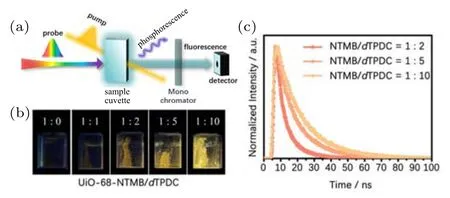
Fig.2.The transient fluorescence.(a) Principle of timecorrelated single photon counting(TCSPC).(b)Photographs and(c)transient fluorescence decay profiles under 365 nm excitation of mixed-linkers UiO-68-NTMB/dTPDC.Figures 2(b) and 2(c) are reproduced with permission from Ref.[33].
Figure 2(b) shows a fluorescence photograph of mixedlinkers UiO-68-NTMB/dTPDC under 365 nm excitation.This MOF material is formed by substituting the central benzene ring of UiO-68 (a MOF composed of [1,1':4',1-terphenyl]-4,4''-dicarboxylic acid (TPDC) and Zr6 clusters)with NTMB(4,4'-(naphtho[2,3-c][1,2,5]-thiadiazole-4,9-diyl)bis(3-methoxybenzoic acid)).By varying the proportion of the nonfluorescent analogdTPDC (2',5'-dimethyl-[1,1':4',1''-terphenyl]-4,4''-dicarboxylic acid)within the MOF,changes in the fluorescence intensity and lifetime can be observed.[32]Its emission signals of the time-resolved fluorescence spectra are illustrated in Fig.2(c).By varying the time delay between the pump and probe pulses,the relationship between fluorescence intensity and time can be established, revealing the entire ultrafast fluorescence decay trajectory during the excited-state relaxation process.The measurement of fluorescence intensity and lifetime can be used to investigate processes such as fluorescence energy transfer, charge transfer, and fluorescence quenching, thereby providing insights into the photoexcitation and energy transfer mechanisms in MOFs.[34,35]These fluorescence characteristics provide valuable information on the radiative transition processes within the material, enabling a better understanding of its structural properties and internal coordination.[36]
2.3.Transient terahertz spectroscopy(TTS)
Time-resolved terahertz spectroscopy is a valuable technique for investigating the dynamic charge transport and vibrational behavior in MOF materials.Terahertz spectroscopy provides crucial information about carrier transport velocity,carrier lifetime,[37]and vibrational modes within the material.[38]Transient terahertz spectroscopy detects the temporal variation of the electric field in the material by generating and detecting terahertz pulses in the time domain,which are then transformed into terahertz spectra to probe the electronic motion processes within the material.
Terahertz pulses can be generated through optical excitation or nonlinear optical processes.For example,femtosecond lasers can induce optical transient effects within a medium,resulting in the generation of terahertz pulses.Another approach involves using photoconductive detectors to receive terahertz radiation generated by the interaction with the material.The temporal and spectral information obtained from time-resolved terahertz spectroscopy allows for the investigation of charge transport dynamics and vibrational modes in MOF materials.This technique provides insights into the behavior of charge carriers and their interactions within the material,contributing to a deeper understanding of the electronic properties and functionality of MOFs.
The experimental setup of transient terahertz spectroscopy is similar to that of fluorescence spectroscopy and transient absorption spectroscopy, with the addition of a THz generation unit in the detection light path (Fig.3(a)).It differs from the other two spectroscopy techniques in terms of capturing complete phase and amplitude information of the terahertz field, rather than the intensity and wavelength relationship observed in fluorescence and absorption spectra.Figure 3 illustrates the three main types of time-domain terahertz experiments.In Fig.3(b), the material is measured using only the detection light, known as THz-TDS (terahertz time-domain spectroscopy), which provides the fundamental terahertz waveform of the material.By gaining insight into the basic terahertz waveform,the optical pump-terahertz probe(OPTP)experiment(Fig.3(c))fixes the detection wavelength at the maximum amplitude of the THz waveform and performs pump-probe detection, yielding OPTP spectra that vary with the relaxation of charge carriers within the material.To understand the terahertz waveform at a specific moment,the pumpprobe delay time is fixed, resulting in the time-resovled terahertz spectroscopy(TRTS)spectrum(Fig.3(d)),which detects the THz signal of the material at a certain time point after optical excitation.[23,29]
To analyze the detected signal from the time domain and obtain the terahertz spectral information of the material,Fourier transform analysis is performed.Fourier transform decomposes the time-domain signal into different frequency components,revealing the material’s absorption,transmission,and reflection characteristics to terahertz waves.By analyzing the Fourier-transformed spectral data, information about vibrations, electronic resonances, and dielectric responses within the terahertz frequency range can be obtained.[39]By measuring terahertz spectroscopic responses and dynamic behavior, valuable insights into charge transport mechanisms,carrier transport processes,and vibrational properties of MOF materials can be obtained.This knowledge is essential for understanding the potential applications of MOFs in optoelectronic devices and sensors.[40,41]
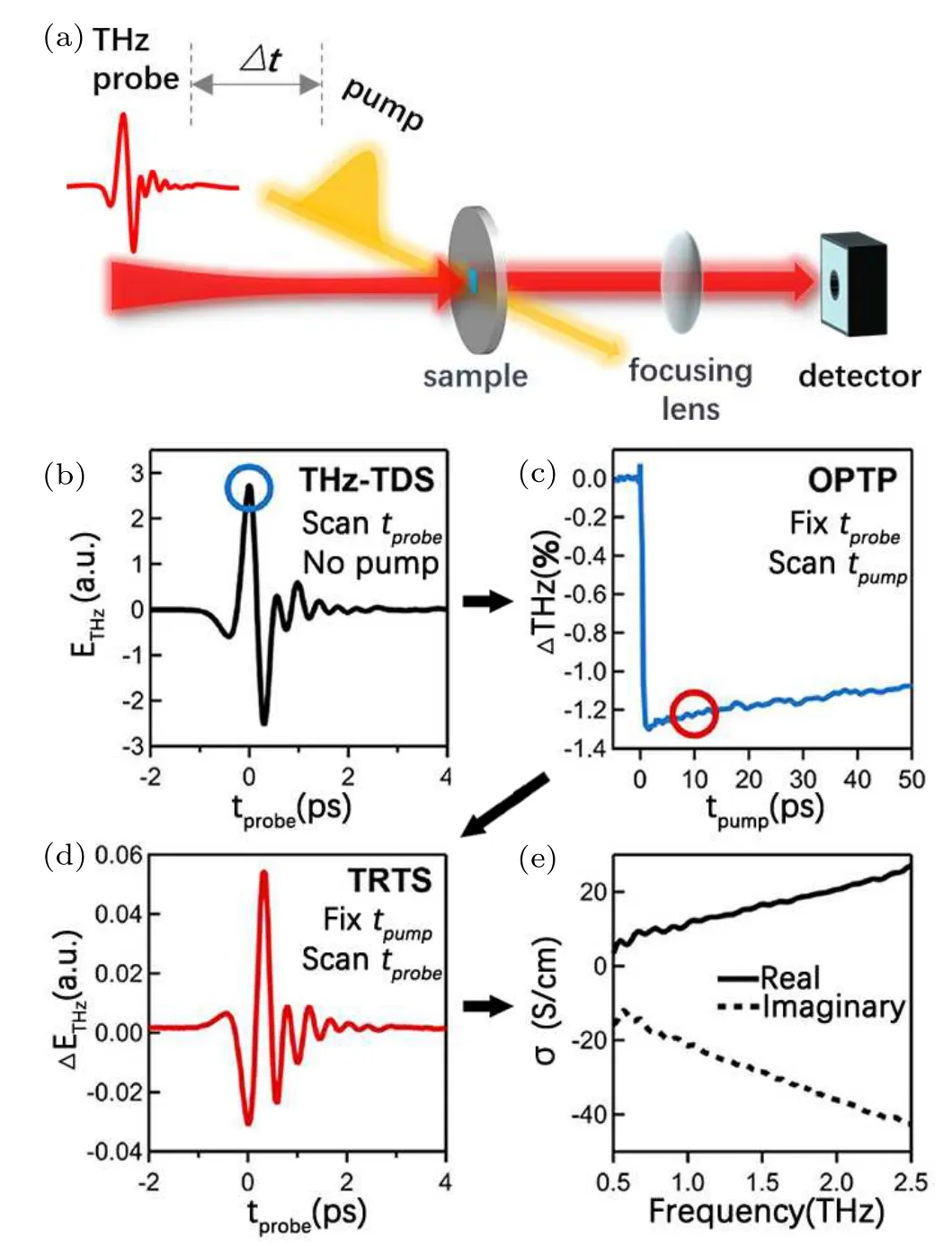
Fig.3.Different information provided by time-resolved THz spectroscopy.(a) THz experimental setup schematic.(b) THz time-domain spectrum without pump(THz-TDS).(c)Optical-pump THz-probe spectrum (OPTP).(d) Time-resolved THz spectrum at fixed delay time(TRTS).(e)Fourier transformed of TRTS to obtain the complex conductivity spectrum.Figure 3 is reproduced with permission from Ref.[23].
To provide a more intuitive comparison of the differences in time resolution and study subjects among the three transient spectroscopic techniques,we have created the following charts for presentation.
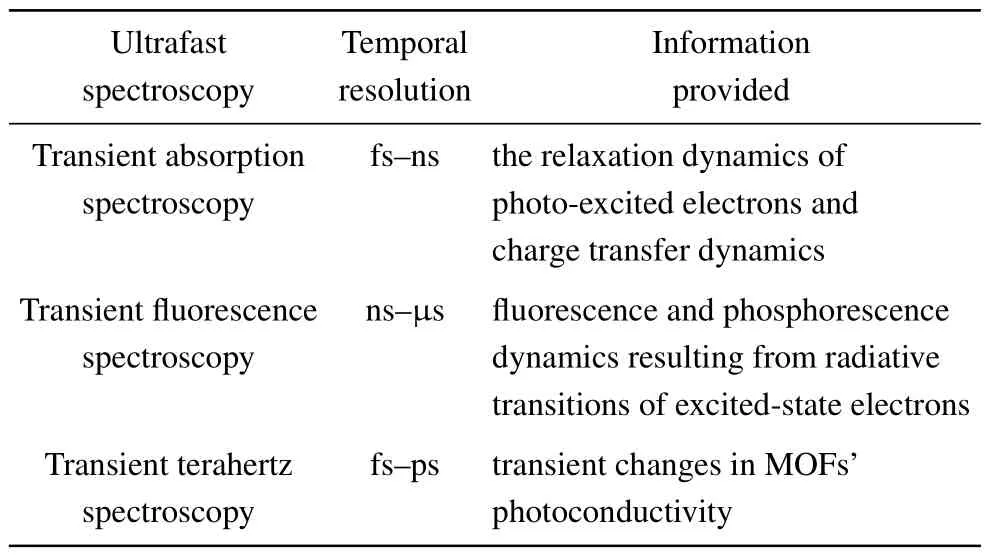
Ultrafast Temporal Information spectroscopy resolution provided Transient absorption fs–ns the relaxation dynamics of spectroscopy photo-excited electrons and charge transfer dynamics Transient fluorescence ns–μs fluorescence and phosphorescence spectroscopy dynamics resulting from radiative transitions of excited-state electrons Transient terahertz fs–ps transient changes in MOFs’spectroscopy photoconductivity
3.Applications of transient spectroscopic techniques in MOFs
MOF materials have garnered significant attention due to their diverse applications in various fields such as photocatalysis,[42–44]photovoltaics,[45]nonlinear optical materials,[19,46,47]and luminescent materials.[48]Transient spectroscopic techniques have played a crucial role in characterizing the properties of MOFs and enhancing their performance through a deeper understanding of the underlying photophysics.
To showcase the application of transient spectroscopy in the study of MOFs,a comprehensive review is conducted,focusing on important findings from the past five years.This review aims to provide insights into the characterization of key properties of MOF materials and highlight the effective enhancement of material performance achieved through a better understanding of photocarrier dynamics.The review likely covers advancements in the field,such as the characterization of excited states, charge carrier generation and recombination processes, energy transfer mechanisms, and the impact of these processes on material functionality and performance.
3.1.Photocatalysis and exciton dynamics of MOFs by TAS
Photocatalysis, as a green and environmentally friendly technology for waste degradation[49,50]and solar energy conversion,[51,52]has received significant attention.The principle of photocatalysis involves the excitation of electrons in materials by light,resulting in the formation of electron–hole pairs.These excited electrons or holes are then transported to catalytic active sites.When the potential energy of the electrons or holes matches the reduction or oxidation potential energy required for the reaction, the photocatalytic redox process is facilitated.Therefore, the main factors affecting the efficiency of photocatalysis are the effective separation of charges and the distance of charge migration.Due to their tunable structures and controllable electronic transition levels,MOF materials have attracted considerable interest in the field of photocatalysis.
To investigate the influence of the structure of MOFs on internal charge separation and migration,Nasalevichet al.[18]studied the effect of different MOF materials with similar topologies but different d0metals as the metal core on charge migration.Figure 4(a)depicts the schematic diagrams of two similar topological structures of MOF materials.In the comparison of the transient absorption spectra in Figs.4(c) and 4(d), they observed that MOFs with Ti as the core exhibited longer excited-state lifetimes compared to other d0metals,indicating enhanced photocatalytic performance due to greater charge separation and longer charge migration distances.This highlighted the significance of the position of the metal core orbitals.In control experiments (Figs.4(d) and 4(e)), MOF crystals with defects exhibited longer excited-state lifetimes than that of theoretical crystals, resulting in improved photocatalytic lifetimes.To investigate the impact of defects on charge migration, Maet al.[53]designed zirconium-based MOF UiO-66-NH2with varying volumes of defects.Their results showed that MOF materials with moderate defect concentration exhibited the fastest relaxation rate and the highest charge separation efficiency.By measuring the photocatalytic hydrogen production rate of different defect-containing MOF materials,the relationship between defects and hydrogen production rate was characterized.It was found that internal defects lowered the energy levels of unoccupied d orbitals of Zr atoms,facilitating the separation and transfer of electron–hole pairs.Higher defect density, however, makes the defects become centers for electron–hole recombination, thereby altering the relaxation rate and charge separation, thus impacting the efficiency of photocatalysis.

Fig.4.(a)and(b)Schematic diagram of different MOF structures formed by d0elements of the same group.(c)Differential transient absorption spectra for titanium-based MOF NH2-MIL-125(Ti)upon excitation at 400 nm and(d)and(e)for zirconium-based MOF NH2-UiO-66(Zr)with varying defect concentrations upon excitation at 370 nm.Figure 4 is reproduced with permission from Ref.[18].
In addition to studying the influence of internal structure on charge separation and migration,researchers have also investigated the effects of doping MOFs with different substances or adding various modifiers on their photocatalytic performance.The interactions between additives and MOFs can also affect electron separation and motion processes.[54–56]
Zhanget al.[57]synthesized new mesoporous heterostructured MOFs by combining c-MIL-125 and c-Cu-BDC MOF materials to study the charge separation dynamics of heterostructured systems.TA spectra of the photosensitizer[Ru(bpy)3]2+(bpy=2, 2'-bipyridine) were separately measured on the insulating substrate Al2O3(Fig.5(b)) and the MOF material(Fig.5(d)).A comparison between the two revealed that upon the combination of photosensitizers and MOF materials,the excited-state absorption peak of the photosensitizer was quenched,indicating that,after a sub-150 fs ultrafast process, electrons were transferred from the photosensitizer to the TiO2core of the MOF, thereby prolonging its excitedstate lifetime.By comparing the transient absorption spectra of copper-based MOF Cu-BDC (Fig.5(c)) and Cu-BDC with the photosensitizer (Fig.5(e)), it was demonstrated that Cu-BDC did not possess catalytic activity but acted as a cocatalyst.This suggested that the photosensitizer transferred electrons to TiO2, followed by the heterogeneous structure transferring electrons to the CuO core for photocatalysis.Liet al.[58]added MoS2to an amino-functionalized iron-based MOF material NH2-MIL-88B-Fe to form a heterostructure.Through transient absorption spectroscopy measurements, it was found that the heterostructured composite material exhibited a twofold increase in excited-state lifetime compared to the pure MOF material, thereby improving the utilization of photo-generated electrons.This phenomenon was attributed to the formation of an internal conversion channel within the heterostructure, enabling electrons to reach lower energy states.Through in-depth investigations by different researchers on the influence of MOF material structure and composition on photocatalytic performance,theoretical support had been provided for the synthesis of more efficient photocatalytic MOF materials.

Fig.5.(a) Schematic diagram of charge transfer process during photocatalysis.Transient absorption spectra of (b) [Ru(bpy)3]2+/Al2O3,(c) [Ru(bpy)3]2+/c-MIL-125, (d) [Ru(bpy)3]2+/c-Cu-BDC, and (e) c-Cu-BDC following 450 nm excitation.Figure 5 is reproduced with permission from Ref.[54].
Besides photocatalysis, the distinctive internal structure and excellent tunability of MOF materials make them highly promising for applications in light absorption and optoelectronic devices.For optoelectronic devices,the speed of charge transfer and the efficiency of charge separation are important metrics.Studying the carrier dynamics processes within anisotropic MOF materials can provide a more comprehensive understanding of how to improve their performance.[59]
Guet al.[60]conducted a thorough investigation of the impact of densely ordered molecular packing on the exciton dynamics of MOF materials in their study.In their experimental approach,they successfully self-assembled cobalt ions and porphyrin linkers ([5,10,15,20-(4-carboxyphenyl) porphyrin],TCPP), resulting in the formation of crystalline and highly oriented porphyrin MOF nanofilms.This careful assembly technique ensured that the internal excitons were arranged in an oriented and densely packed configuration (Fig.6(a)).To evaluate the effect of molecular packing on the exciton dynamics, the researchers employed time-resolved fluorescence spectroscopy (Fig.6(b)).Comparing their findings with isolated excitons in solution, the team observed significantly shorter exciton lifetimes in the densely packed state of MOFs.To determine the underlying cause of this phenomenon, the researchers carefully investigated various potential processes,such as exciton transfer between ligands and metal centers or assembly-induced super-radiation, by examining the absorption and emission spectra.

Fig.6.(a) Schematic diagram of the process from isolated excitons to exciton arrays formation.(b) Exciton lifetime in isolated excitons and exciton arrays formation.(c)TA traces of MOF nanofilms at different excitation fluences.(d)The proportion changes of the three different decay processes as the flux increases.Figure 6 is reproduced with permission from Ref.[60].
To validate whether the observed shorter exciton lifetimes were attributable to exciton–exciton annihilation,a nonradiative process influenced by exciton density, Guet al.performed excitation–energy-dependent transient absorption spectroscopy(Figs.6(c)and 6(d)).By fitting the transient absorption spectra of distinct lifetime processes,the researchers were able to confirm the presence of a decay process that exhibited a positive correlation with exciton density.This finding unequivocally demonstrated that exciton–exciton annihilation played a major role in the reduction of exciton lifetime in the densely packed MOF nanofilms.
In addition to studying the influence of MOF structure on photoelectrochemical conversion, researchers also aim to improve the optoelectronic properties by introducing additional materials into the pores of the material.Lianget al.[61]investigated the modulation of conductivity and photoconductivity of the terbium-based semiconductive MOF TbTATAB(Tb2L2·H2O·6DMF,L= TATAB3?,4,4',4''-s-triazine-1,3,5-triyltri-p-aminobenzoate, DMF=N, N-dimethylformamide)by incorporating the electron acceptor molecule rhodamine B (RhB) into its pores.They characterized the exciton dynamics of the RhB-doped and undoped MOF materials using transient absorption spectroscopy to understand the impact of host-guest interactions on exciton formation and dynamics within the MOF.Figures 7(a)and 7(b)demonstrate the effects arising from host-guest interactions.By comparing the transient absorption spectra of the doped and undoped MOF materials in Figs.7(c) and 7(d), it is observed that the introduction of the electron acceptor molecule significantly affected the electron transfer process within the MOF,resulting in improved exciton transfer speed and separation efficiency.
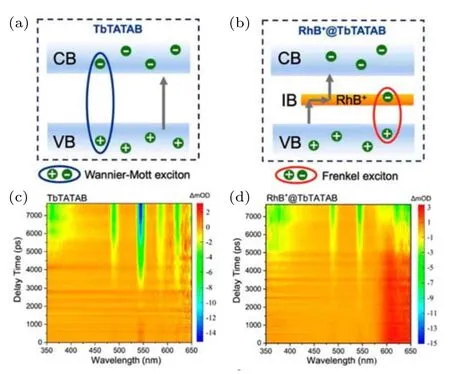
Fig.7.(a) and (b) Diagram illustrating the change in electron trajectory before and after doping with electron-deficient molecules.(c)and(d)TA spectra for TbTATAB and RhB+@TbTATAB.Figure 7 is reproduced with permission from Ref.[61].
3.2.Fluorescence quenching and enhancement of MOFs by TFS
Fluorescence has played a significant role in fields such as optical/chemical sensing,energy conversion,etc.[62–64]By enhancing the fluorescence emission properties, it is possible to improve light absorption in artificial photosynthesis,create brighter light-emitting diodes(LEDs),enhance the sensitivity and response speed of optical devices,as well as improve the transmission rate and performance of optical communication systems.[22,32,65]
To enhance the fluorescence emission efficiency of nanoscale MOF materials, Monguzziet al.[66]employed poly methyl methacrylate(PMMA)coating on nanocrystalline MOF to improve its fluorescence performance.As shown in Fig.8(b),by measuring the time-resolved fluorescence spectra of the nanocrystalline MOF,the authors characterized the fluorescence lifetimes of the MOF in the PMMA solid state, in benzene solution,and at low temperatures(77 K).The results demonstrated that the surface effects on the fluorescence lifetime of the MOF material were much greater than the temperature effects.To investigate the origin of PMMA’s effect on the MOF material,the authors performed spectroscopic characterization of the transient fluorescence spectra of MOF materials with different sizes under PMMA encapsulation.It was inferred that the gain in fluorescence performance from PMMA coating was less pronounced for larger-sized MOF materials,suggesting that PMMA effectively reduces the surface nonradiative recombination in the MOF material.
Singlet and triplet states play a crucial role in enhancing the energy conversion efficiency of photovoltaic devices.The interconversion between singlet and triplet states can occur to promote the application of MOFs in light energy conversion.Taking advantage of the versatile MOF structure,Rajasreeet al.[67]investigated how to control singlet fission efficiency by adjusting the material’s topological structure and filling density through the preparation of three different topological structures of MOFs.Through photon up-conversion,singlet and triplet states can be merged to form singlet states.To enhance the photon up-conversion capability of crystals,as shown in Fig.9(a),Meinardiet al.[68]fabricated nanoscale MOF crystals using organic materials and employed crystals with dimensions much smaller than the exciton diffusion length to ensure efficient collisions between triplet excitons,thereby increasing the probability of photon up-conversion.To investigate the influence of encapsulation in different phases on the nonradiative transition processes of the nano MOF material Zn-ADB (the combination of ADB (4,4'-(anthracene-9,10-diyl)dibenzoate) and Zn2+ions), researchers conducted transient fluorescence spectroscopy experiments on MOF materials placed in liquid and solid environments.And they also performed similar experiments on the organic ligands(ADB)under solid-state encapsulation.In the transient fluorescence spectrum (Fig.9(b)), the MOF material encapsulated in poly butylacrylate (PBA) exhibits a higher fluorescence lifetime compared to that in liquid benzene,indicating that solid-state encapsulation reduces fluorescence quenching and decreases the influence of surface nonradiative recombination processes on the up-conversion process.Additionally, transient fluorescence spectroscopy(Fig.9(c))analysis of the phosphorescence of the MOF material and its organic matrix revealed an accelerated decay rate of phosphorescence upon formation of the MOF material, indicating a significant enhancement in photon up-conversion capability.

Fig.8.(a)A schematic diagram illustrating the alteration of the transition processes of singlet excitons in MOF materials before and after encapsulation.(b)The influence of detection temperature and encapsulation on the photoluminescence(PL)decay of MOF.Figure 8 is reproduced with permission from Ref.[66].

Fig.9.(a)Schematic diagram of the photon up-conversion process based on the sensitized triplet–triplet annihilation(sTTA).(b)A comparative analysis of photoluminescence(PL)decay in MOF material in different solvents and its matrix.(c)Transient fluorescence spectra illustrating the decay process of triplet excitons.Figure 9 is reproduced with permission from Ref.[68].
In addition to singlet and triplet states, triplet–triplet fusion (quintet TT) has also been observed in MOFs.Haet al.[69]chose MOF materials with both inorganic and organic structural units as an experimental platform to investigate the process of quintet TT to singlet state conversion.They achieved quintet TT at moderate magnetic fields at room temperature and successfully demonstrated the conversion to singlet states, confirming the significant influence of the unique spatial structure within MOFs on the quintet TT process.
The generation of fluorescence originates from the decay of excited states, while the emission process represents radiative transitions of energy,and after a time scale of ps–ns,electrons return to the ground state and fluorescence ceases.However, by modifying the internal structure of the material or attaching certain substances to the material surface,energy transfer can occur, leading to fluorescence quenching or enhancement.Exploiting this phenomenon, materials can be utilized for fluorescence detection and optical storage.The key advantage of MOF materials lies in their ability to control the emission location and process by selecting appropriate materials.To better design materials for fluorescence detection and optical storage,it is crucial to investigate the dynamic processes of fluorescence within the materials and understand how they contribute to fluorescence enhancement and quenching.
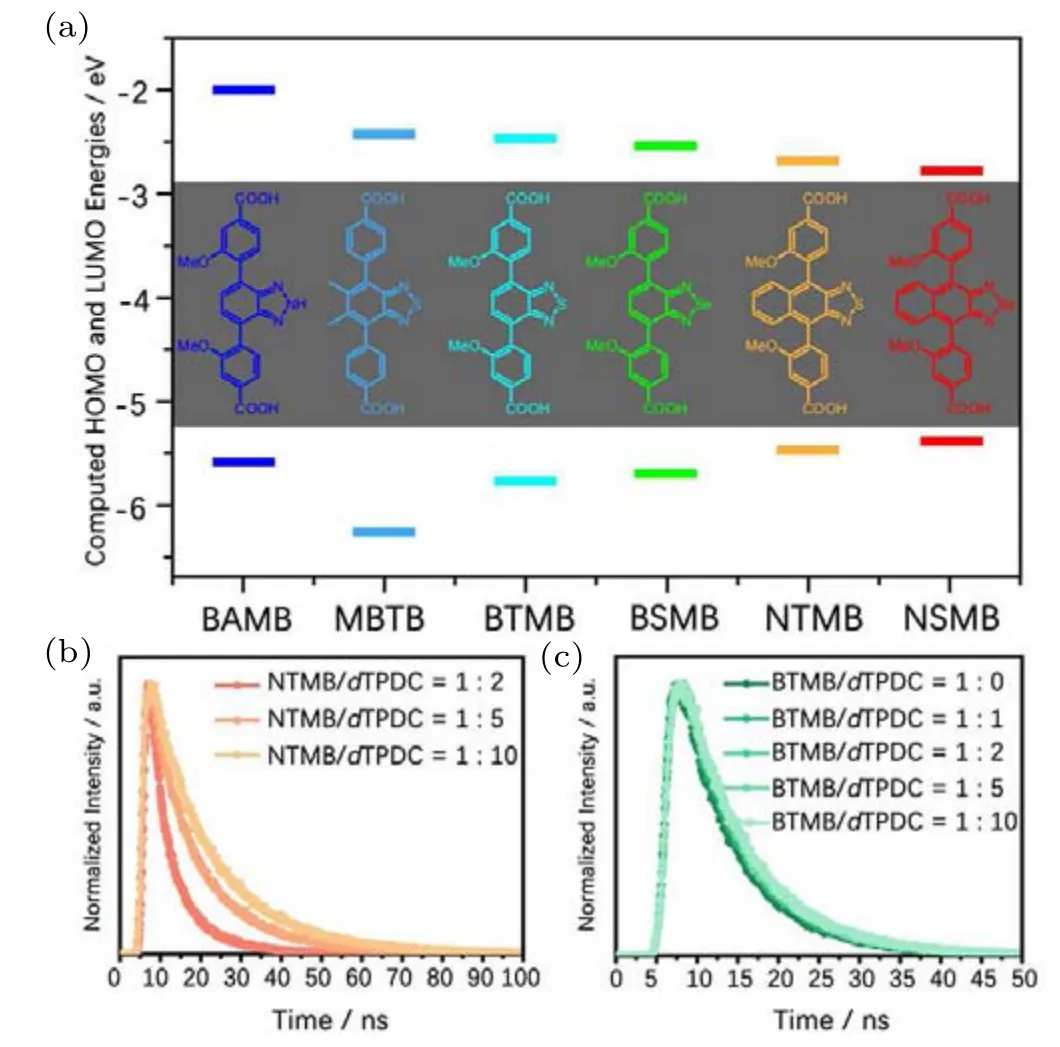
Fig.10.(a)Molecular structures and calculated HOMO–LUMO energy levels of six 2,1,3-benzothiadiazole-based linkers.(b) and (c) Transient fluorescence decay profiles of mixed-linkers UiO-68-NTMB/dTPDC and UiO-68-BTMB/dTPDC(under different concentrations of dTPDC).Figure 10 is reproduced with permission from Ref.[32].
The study conducted by Wuet al.[32]aimed to develop MOF materials with full-color emission capability.They achieved this by modifying the structures of different ligands in UiO-68-type MOFs.By tuning the energy levels of the highest occupied molecular orbital (HOMO) and lowest unoccupied molecular orbital(LUMO),they enabled the materials to emit fluorescence of varying colors (Fig.10(a)).During the synthesis process, they observed fluorescence self-quenching due to the dense packing of the MOF structure.To enhance the fluorescence excitation performance,they introduced non-fluorescent linkers to reduce the structural density.The effect of inserting these non-fluorescent linkers into the MOF structures on the fluorescence excitation performance was investigated using transient fluorescence spectroscopy.Figures 10(b) and 10(c) show that upon adding the same proportion of non-fluorescent linkerdTPDC,the increase in fluorescence lifetime was more pronounced for the smaller-sized NTMB (4,4'-(naphtho[2,3-c][1,2,5]-thiadiazole-4,9-diyl)bis(3-methoxybenzoic acid)), while the larger-sized BTMB (4,4'-(benzo[c]-[1,2,5]thiadiazole-4,7-diyl)bis(3-methoxybenzoic acid)) showed little change.This suggested that the presence of non-fluorescent linkers has a greater impact on smaller-sized MOF structures.
By increasing the content of non-fluorescent linkers,they effectively address the fluorescence quenching issue caused byπ–πstacking interactions,thereby reducing the impact of nonradiative transition processes and improving the emission efficiency.Importantly,this solution is not limited to specific materials and can be applied in the synthesis of other MOF materials.Overall, the study demonstrates a strategy to achieve full-color emission capability in MOF materials by manipulating their structures and addressing fluorescence quenching issues.This has potential implications for the development of advanced optoelectronic devices and sensors based on MOFs.
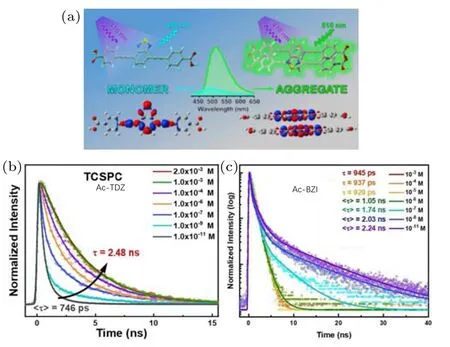
Fig.11.(a) Schematic diagram of the photoexciting process in AC-BZI (4,4'-((1H-benzo[d]-imidazole-4,7-diyl)bis(ethyne-2,1-diyl))dibenzoic acid) and in AC-TDZ (4,4'-(benzo[c][1,2,5]thiadiazole-4,7-diylbis(ethyne-2,1-diyl))dibenzoic acid).AC-TDZ exhibits ICT in the excited state,facilitating enhanced emissive aggregation.(b)Fluorescence decays for AC-TDZ at different concentrations measured by timecorrelated single-photon counting (TCSPC).(c) TCSPC for AC-BZI at different concentrations in the solvent.Figure 11 is reproduced with permission from Ref.[33].
In the study of fluorescence, apart from avoiding aggregation-induced quenching,there is another phenomenon called aggregation-induced emission (AIE), where the fluorescence emission intensity and lifetime are enhanced upon aggregation of chromophores.To investigate the underlying mechanism of this phenomenon, Guti′errez–Arzaluzet al.[33]employed a conjugated electron–donor–acceptor–donor (D–A–D) chromophore, as shown in Fig.11(a), which can serve as an organic linker in MOFs.After the confirmation of the presence of intramolecular charge transfer(ICT)processes by steady-state fluorescence spectroscopy, the influence of ICT on the aggregation-induced emission was examined by transient fluorescence spectroscopy,based on the comparison between the chromophore exhibiting AIE (Fig.11(b)) and a control material without AIE (Fig.11(c)).The fluorescence spectra of the chromophore exhibited a transition from a biexponential decay at low concentrations to a single exponential decay at the highest concentration,indicating a significant suppression of non-radiative processes.In contrast,the control material without AIE showed aggregation-induced quenching with increasing concentration.These findings demonstrated that intramolecular charge transfer and the unique branching of the chromophore are critical for the occurrence of aggregation-induced emission.
The optimization of fluorescence emission performance is closely related to factors such as the chemical composition,structural design, and fabrication processes of materials.By characterizing and studying the excitation, enhancement, and quenching processes of fluorescence, and understanding the influence of structure and chemical composition on radiative transitions,material design can be tailored to meet the requirements of different application fields.
3.3.Photoconduction of MOFs by TTS
Time-resolved terahertz spectroscopy is a promising technique for measuring the photoconductivity of materials, and its potential for utilization in metal-organic framework(MOF)materials has been recently explored.
The study by Pattengaleet al.[40]focused on utilizing transient terahertz spectroscopy to measure the photoconductivity of polycrystalline MOF materials.In particular, they investigated the effect of pressure on the internal photoconductivity dynamics of Zn2TTFTB, where TTFTB stands for tetrathiafulvalene tetrabenzoate.To examine the influence of pressure,the researchers applied varying levels of pressure to the material.They then used transient terahertz spectroscopy to measure the resulting photoinduced conductivity.The experimental data revealed interesting findings.Figure 12(a)displays the results, indicating that there were no significant changes in the photoconductivity dynamics due to the applied pressure.However,an improvement in photoconductivity was deduced from the frequency-dependent alterations in photoconductivity.These changes suggested a variation in the distances between the grains of the material (intergranular distances).Furthermore, the researchers performed an analysis of the time-dependent terahertz amplitude data, as shown in Fig.12(c).This analysis revealed two distinct decay processes, from which the changes in internal photoconductivity were inferred.The obtained results demonstrated an improvement of two orders of magnitude compared to traditional probe-based measurement techniques.This highlighted the higher precision and accuracy of spectroscopic techniques in comprehensively understanding the changes in the photoconductivity dynamics of the material.

Fig.12.(a) The frequency-resolved TRTS data show no changes due to applied pressure.(b) Photoconductivity shows a slight increase in magnitude for the pressed sample.(c)Representative OPTP trace of Zn2TTFTB MOF.Figure 12 is reproduced with permission from Ref.[40].

Fig.13.(a)Schematic diagram of the charge transfer mechanism.(b)The comparison of OPTP traces of the Cu-THQ and Cu/Zn-THQ.Figure 13 is reproduced with permission from Ref.[41].
Currently, there are two approaches to enhance the conductivity of MOF materials: constructing MOF materials with metal core and organic ligand orbital overlap, and creating extended pathways that enable electron delocalization.To investigate the influence of electron motion on the photoconductivity behavior in MOF materials at both temporal and spatial scales, as shown in Fig.13(a), Nyakuchenaet al.[41]constructed a two-dimensional MOF material, XTHQ(tetrahydroxyquinone)with electron delocalization pathways and performed transient terahertz spectroscopy studies.The attenuation of terahertz oscillations can be attributed to processes such as electron–hole recombination, carrier trapping by electron traps, and relaxation to stable energy levels.As shown in Fig.13(b), during the incorporation of Zn into Cu-THQ,a significant decrease in the peak intensity of the terahertz spectrum is observed,indicating that the presence of Zn reduces the electron mobility and carrier density, thereby decreasing the photoconductivity.The introduction of Zn alters the electron trajectory within the MOF material.By studying the trend of terahertz amplitude changes during the substitution of Cu with Zn,the impact of electron motion on the photoconductivity at the spatial scale is characterized.This study provides insights into how to enhance the photoconductivity of MOF materials by constructing electron transfer pathways.
4.Summary and outlook
We have discussed the latest advancements in the use of transient spectroscopic techniques for studying MOF materials.Since their discovery in the 1990s, MOF materials have been extensively investigated for over two decades.Initially regarded as porous materials for gas separation and storage, MOFs have now found widespread applications in various fields such as photocatalysis, photovoltaic devices, lightemitting diodes, and nonlinear optical devices.To enhance their performance in these applications, it is crucial to understand the underlying dynamic processes of photoinduced carrier dynamics.This understanding enables the prediction, interpretation, and targeted improvement of their performance.Although significant progress made in investigations of photocarrier transport,recombination,interaction,and transfer processes in MOFs with ultrafast spectroscopies, challenges remain in the photophysics of MOFs.
(i)Although the photocarrier dynamics within MOF materials is well understood, there is still a viable research direction to explore the influence of external stimuli, such as doping,applied electric fields,or combining with other materials/optical cavities,on their non-equilibrium performances.
(ii) Despite efforts to suppress nonradiative processes through coupling with other materials or encapsulation,MOFs still do not exhibit significantly high PL quantum yield compared to other inorganic and organic fluorescent materials.The understanding of the internal nonradiative transition processes is still incomplete,and further investigations are needed to enhance the intrinsic fluorescence emission of MOFs.
(iii) Previous research has investigated the influence of metal cores and organic linkers on the bandgap width of MOFs, focusing on the selection of appropriate building blocks for MOF assembly.The role of defects or introduced surface states has been largely overlooked and should be clarified in future investigations.
(iv) With the advancement of synthesis techniques, lowdimensional MOF nanofilms and nanosheets have been successfully developed.Compared to the bulk counterparts, the reduced dielectric screening and carrier localization could result in an enhanced multi-carrier binding energy.Therefore,the investigation of quasiparticle dynamics (exciton, trion,biexction, excimer, etc.) in low-dimensional MOFs is highly desirable and a prerequisite for the development of MOFbased compact devices.
Acknowledgments
Project supported by the Science Challenge Project(Grant No.TZ2018001), the National Natural Science Foundation of China (Grant Nos.11872058 and 21802036), the Project of State Key Laboratory of Environment-friendly Energy Materials, and Southwest University of Science and Technology(Grant No.21fksy07).
- Chinese Physics B的其它文章
- High responsivity photodetectors based on graphene/WSe2 heterostructure by photogating effect
- Progress and realization platforms of dynamic topological photonics
- Shape and diffusion instabilities of two non-spherical gas bubbles under ultrasonic conditions
- Stacking-dependent exchange bias in two-dimensional ferromagnetic/antiferromagnetic bilayers
- Controllable high Curie temperature through 5d transition metal atom doping in CrI3
- Tunable dispersion relations manipulated by strain in skyrmion-based magnonic crystals

